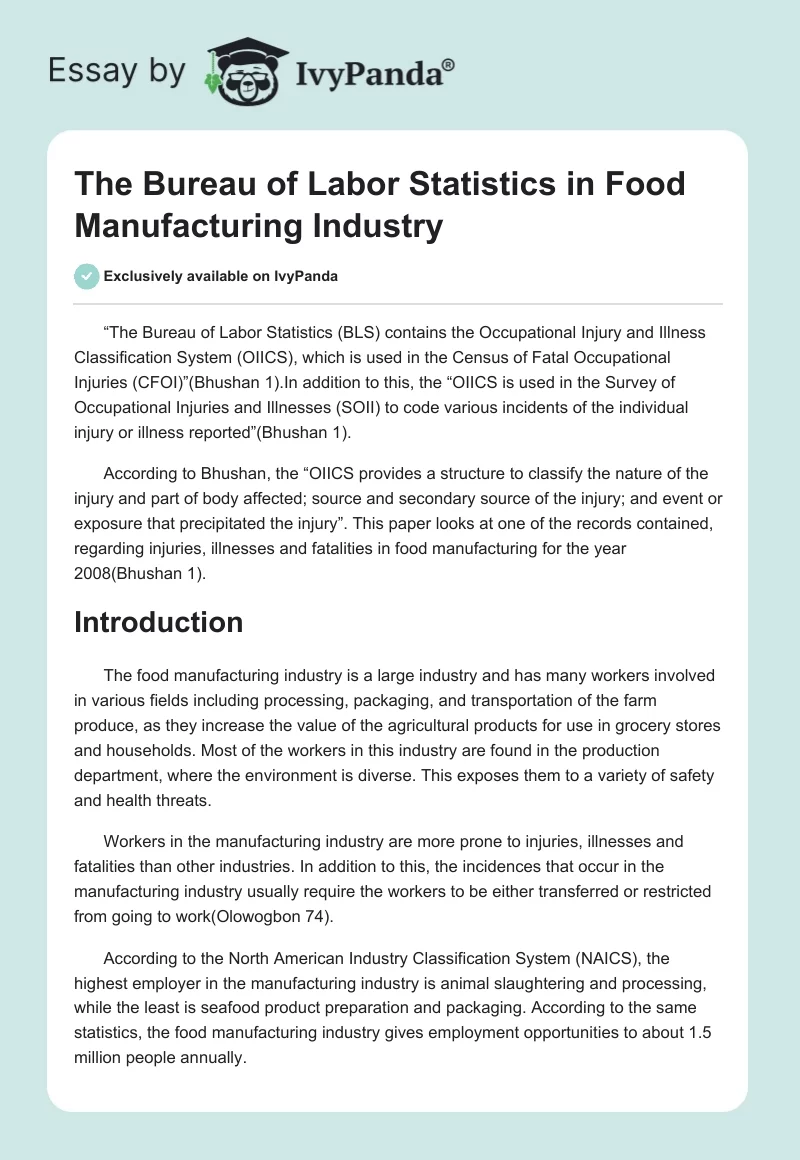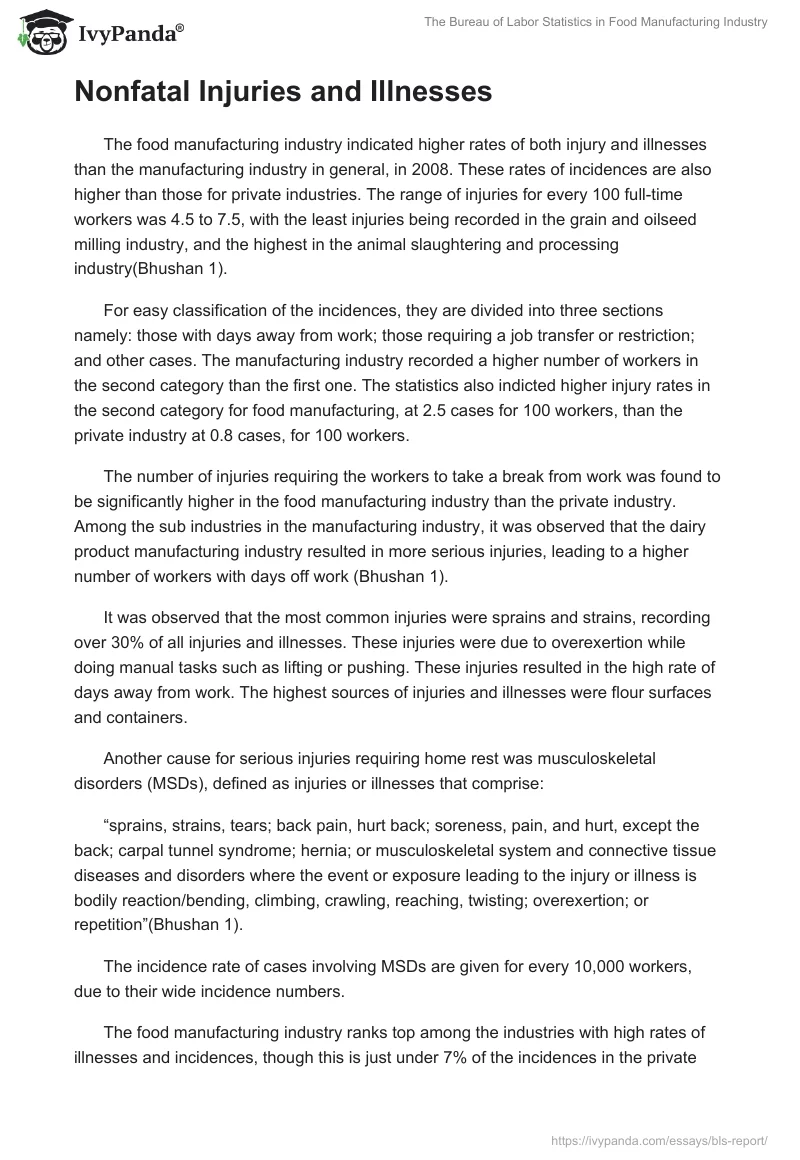“The Bureau of Labor Statistics (BLS) contains the Occupational Injury and Illness Classification System (OIICS), which is used in the Census of Fatal Occupational Injuries (CFOI)”(Bhushan 1).In addition to this, the “OIICS is used in the Survey of Occupational Injuries and Illnesses (SOII) to code various incidents of the individual injury or illness reported”(Bhushan 1).
According to Bhushan, the “OIICS provides a structure to classify the nature of the injury and part of body affected; source and secondary source of the injury; and event or exposure that precipitated the injury”. This paper looks at one of the records contained, regarding injuries, illnesses and fatalities in food manufacturing for the year 2008(Bhushan 1).
Introduction
The food manufacturing industry is a large industry and has many workers involved in various fields including processing, packaging, and transportation of the farm produce, as they increase the value of the agricultural products for use in grocery stores and households. Most of the workers in this industry are found in the production department, where the environment is diverse. This exposes them to a variety of safety and health threats.
Workers in the manufacturing industry are more prone to injuries, illnesses and fatalities than other industries. In addition to this, the incidences that occur in the manufacturing industry usually require the workers to be either transferred or restricted from going to work(Olowogbon 74).
According to the North American Industry Classification System (NAICS), the highest employer in the manufacturing industry is animal slaughtering and processing, while the least is seafood product preparation and packaging. According to the same statistics, the food manufacturing industry gives employment opportunities to about 1.5 million people annually.
Nonfatal Injuries and Illnesses
The food manufacturing industry indicated higher rates of both injury and illnesses than the manufacturing industry in general, in 2008. These rates of incidences are also higher than those for private industries. The range of injuries for every 100 full-time workers was 4.5 to 7.5, with the least injuries being recorded in the grain and oilseed milling industry, and the highest in the animal slaughtering and processing industry(Bhushan 1).
For easy classification of the incidences, they are divided into three sections namely: those with days away from work; those requiring a job transfer or restriction; and other cases. The manufacturing industry recorded a higher number of workers in the second category than the first one. The statistics also indicted higher injury rates in the second category for food manufacturing, at 2.5 cases for 100 workers, than the private industry at 0.8 cases, for 100 workers.
The number of injuries requiring the workers to take a break from work was found to be significantly higher in the food manufacturing industry than the private industry. Among the sub industries in the manufacturing industry, it was observed that the dairy product manufacturing industry resulted in more serious injuries, leading to a higher number of workers with days off work (Bhushan 1).
It was observed that the most common injuries were sprains and strains, recording over 30% of all injuries and illnesses. These injuries were due to overexertion while doing manual tasks such as lifting or pushing. These injuries resulted in the high rate of days away from work. The highest sources of injuries and illnesses were flour surfaces and containers.
Another cause for serious injuries requiring home rest was musculoskeletal disorders (MSDs), defined as injuries or illnesses that comprise:
“sprains, strains, tears; back pain, hurt back; soreness, pain, and hurt, except the back; carpal tunnel syndrome; hernia; or musculoskeletal system and connective tissue diseases and disorders where the event or exposure leading to the injury or illness is bodily reaction/bending, climbing, crawling, reaching, twisting; overexertion; or repetition”(Bhushan 1).
The incidence rate of cases involving MSDs are given for every 10,000 workers, due to their wide incidence numbers.
The food manufacturing industry ranks top among the industries with high rates of illnesses and incidences, though this is just under 7% of the incidences in the private industry. In the study year, 2008, the incidence rates in the food manufacturing industry were about four times that of the private industry.
Out of the recordable illness cases, which include skin disorders, respiratory problems, poisoning and hearing loss, workers in the food manufacturing industry indicated higher chances of suffering from hearing loss, and less of respiratory problems, than the private industry (Bhushan 1).
The workers in the food manufacturing industry who are most prone to injuries and illnesses are those in production, with about 50% of the industry incidents happening to them. The production category in the food manufacturing industry can be further sub-divided into various occupation groups, including: “supervisors of production workers, assemblers and fabricators, food processing workers, metal and plastic workers, plant and system operators, and other production workers” (Bhushan 1).
The statistics indicated that the food processing workers as well as other production workers represented more than 85% of the injuries and illnesses occurring to workers in the food manufacturing industry(Bhushan 1).
Fatal Workplace Injuries
An increase in the number of fatalities was recorded in the food manufacturing industry from 2007 to 2008, making it the highest ranked manufacturing industry with fatal workplace injuries. Out of the various activities in the food manufacturing industry, the transportation industry recorded the highest fatalities.
This was attributed to fires and explosions in the line of duty. Fatalities were also observed to result from contact with objects and equipment. The sub-industry with the highest number of fatalities in food manufacturing was the sugar and confectionary industry. “The increase in number of deaths in this industry was due to the explosion of a sugar factory in Port Wentworth, Georgia, in 2008” (Bhushan 1).
“There was about 75 critical injuries by workers in 2008, most of which were observed to result from severaldistressing injuries”(Bhushan 1). Traumatic injuries accounted for about half of those injuries caused by multiple traumas.
“The primary source of fatal workplace injuries in the food manufacturing industry in 2008 were caused by vehicles, including highway trucks and automobiles; while the secondary source included persons, plants and minerals”(Bhushan 1). Another relevant statistic was the gender of the industry incidences.
It was observed that most of the workers who had fatal injuries were men, aged between 36 and 65. About half of this number was taken up by white and non-Hispanic workers, with equal race distribution. Most of the fatalities in the food manufacturing industry in 2008 were observed to come from the production and transportation and material moving occupations(Bhushan 1).
Conclusion
Out of all the people in the private industry, those working in the food manufacturing industry are more vulnerable to both fatal and nonfatal injuries. Workers in the food manufacturing industry are also observed to acquire more minor injuries than serious ones, and therefore end up with either job transfers or restriction as opposed to rest days.
Most of the workers in the food manufacturing industry work in the field of production, where most of the injuries occurring are nonfatal; however, the production sub-division of transportation and material moving records the highest number of fatal injuries (Bhushan 1).
Works Cited
Bhushan, Nivedita L. Injuries, Illnesses, and Fatalities in Food Manufacturing, 2008. 21 January 2011. Web.
Olowogbon, Samuel Toyin. “Health and Safety in Agriculture and Food Security Nexus.” International Journal of Emerging Sciences (2011): 1(2), 73-82. Print.




